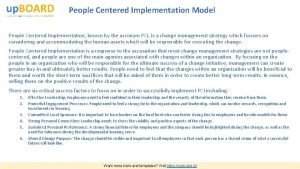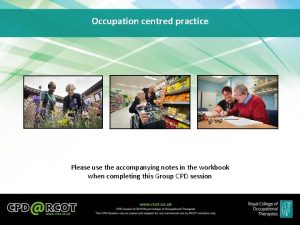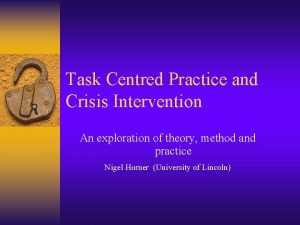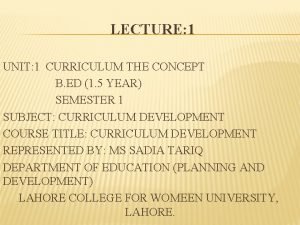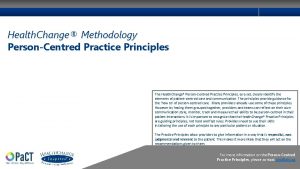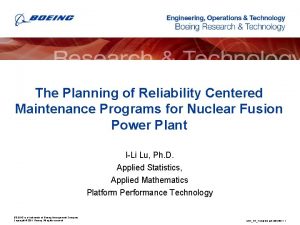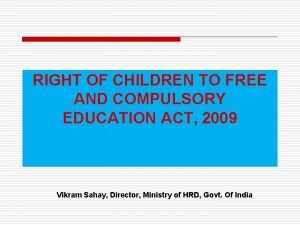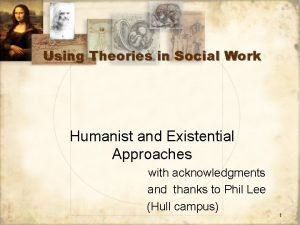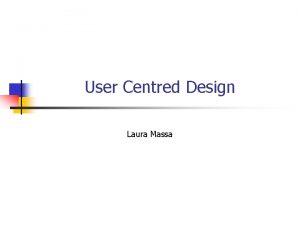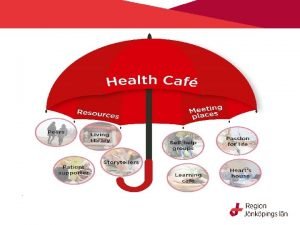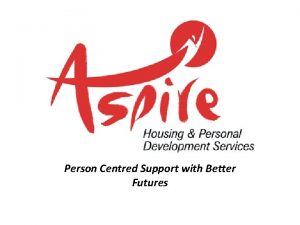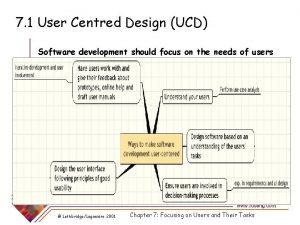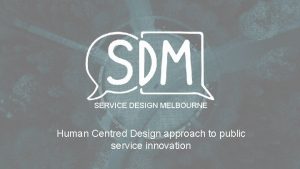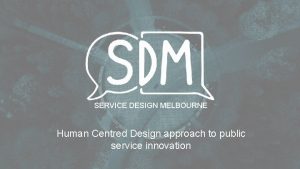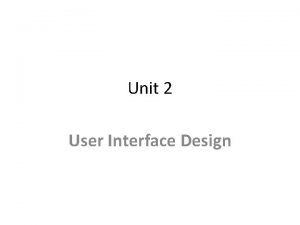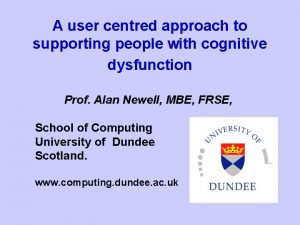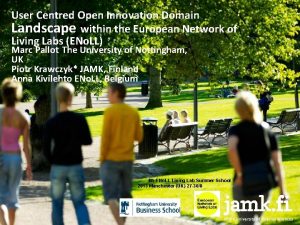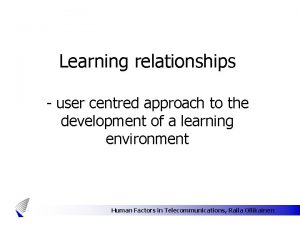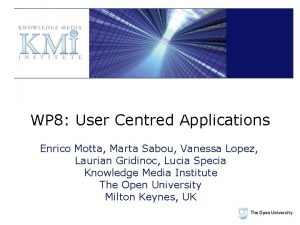PUDECAS A Platform for User Centred Design and


















- Slides: 18

PUDECAS: A Platform for User. Centred Design and Evaluation of Context-Aware Adaptive Services Progress Report Vincent Wade – PI TCD Simon Dobson – PI UCD David Lewis Knowledge and Data Engineering Group (KDEG), TCD Systems Research Group (SRG), UCD 10 th June 2009 vincent. wade@cs. tcd. ie simon. dobson@ucd. ie dave. lewis@cs. tcd. ie 1 http: //kdeg. cs. tcd. ie http: //www. ucd. ie/csi

Starting Point • To reduce the cost & delay and increase the effectiveness of evaluating the user experience of context-aware services using virtual reality simulation • Target Markets are those developing and selling: 1. Location-aware mobile services 2. Smart buildings 3. Future Ubiquitous Computing applications 2

Benefits PUDECAS is a cutting edge, experiential tool that can rapidly present different usage scenarios to bring context aware mobile services alive for the user. Reduce risks of user acceptance when developing new mobile services Low-cost virtual trials to gauge user reaction Experiential Selling • Unique Selling Points: – Rapid Development: A focus on the productivity of those designing and evaluating mobile/ubiquitous computing user experiences – Distributed, Multi-User Interaction: Mobile 2. 0 ready – Architected Flexibility: Makes the tool viable across rapidly evolving mobile service and context-aware technologies 3

Technical Architecture Experimental Design Tool Adaptive Service Modelling Tool System Under Test service context Adaptive Service Layer combined context Context Fusion Modelling Tool Context Services Layer actuations simulated context Context Fidelity Modelling Tool Simulated Context Generation generated context Map and Sensor Editor Interactive Context Generation (game server) generated context Questionnaire Authoring Tool Adaptive User 4 Instrumentation Game Client

User Experience: Evaluation System Interface • Adaptive User Instrumentation • Question user when relevant event is experienced 5

Tech Progress: Adaptive User Experience Questionnaire 6

Experimental Design Tool • • 7 An Integrated Development Environment Eclipse open source platform Integrate set of plug-ins Graphical Modelling Framework – Meta-data driven direct manipulation interface

Tech Progress on Tool Set • Flexible modelling for handling a variety of simulated context flows • Ability to model and manage context fidelity • Modelling of uncertainty in context processing 8

Directions: Re-tooling Runtime Simulator • Is the current tooling appropriate? – Open-source, game (and therefore user) oriented – Hard to develop new landscapes, not trivial to integrate sensors • An intern is re-evaluating the requirements for tooling – Games engines – VR and other approaches – How has the technology changed? How important is graphical fidelity? Is there an alternative platform? 9

Focus: areas difficult to plan • Sensor coverage and interactions • Sensor fidelity and accuracy – Pervasive uncertainty complicates the provision of services, leads to problems with roll-backs – How problematic are these areas in practice? • Resolving uncertainty – Structuring space using lattices, combine measures of uncertainty in a principled way (ICPS’ 08, PERVASIVE’ 08) 10

Verifying Objectives • Support rapid exploration of heterogeneous contextaware applications in different usage scenarios – Usability studies of tool for modelling the flow of context for such scenarios. • Flexibility verified through modelling of a representative range of – simulated environments • driven by different investigation scenarios – sensors and sensor deployments – context processors and context-aware applications 11

Commercialisation: Mobile Industry Value Chain Mobile Phone Manufacturer User Evaluation 3 rd Party Platform Service Provider Retail Mobile Service Provider User Evaluation Platform R&D User Evaluation Platform Marketing & Sales Retail Development Experiential Selling 12 Operations & Customer Relations Customer

Commercialisation Planning • Primary Market: Mobile Telecoms Industry – Service Development: • • Mobile operators spend 6 -10% on R&D Upto a third of this is on testing Sell Platform as software package + training & support BUT: integration of wide range of sensor with mobile apps slow to emerge – with GPS/GSM location, USP in flexible context processing is lost – Sales and Marketing: • Sell User experience kiosk/web + experience development service • Now seem most promising near term commercialisation route • Secondary targets emerging: – Smart Building Development: integration with architectural tools – Education and Training: Networked Embedded systems 13

Opportunities in NEMBES Project Architectural CAD, Thermal Flow CAD Net Simulators, Device Emulators PUDECAS Ubicomp Usability Tool (TCD/UCD) Reuse Integrated Tool Chain Delivery Lab Cave Web Ubi. Aware Wireless planning tools (CIT) Model repository using standardised 14 Industry Foundation Classes

Team and Time Line • • TCD Team: – Vincent Wade, PI – Eleanor O’Neill, Research Assistant – David Lewis, Senior Researcher – moved to NEMBES - Oct’ 07 – Kris Mc. Glinn, Ph. D Student – moved to NEMBES – Oct’ 07 Non-funded TCD participants: – 7 MBA students – 4 MSc dissertation project students – Undergrad trial students UCD – Simon Dobson, PI – Mark Sullivan, postgrad student, left Jan’ 07 – Susan Mc. Keever, lecturer at DIT, joined on sabbatical Sept’ 07 No-cost extension request! – 9 -12 months – Refactor UCD spend due to personnel change – Re-focus effort spend on Experiential Selling Commercialisation at TCD 15

Reports and Deliverables • Completed: – D 1: Initial requirements for Experimental Design Tool – D 2: Initial adaptive service meta-model – D 3: Evaluation report for initial integrated platform operation – D 4: Experimental Design Tool user guide • In Progress: – D 5: Market Survey Report – move from user evaluation to experiential selling • Future: – D 6: Evaluation report for enhanced integrated platform operation – D 7: Final Technical Report 16

IPR • IPR protection primarily through software copyright • Preferred Commercialisation route: – Spin-out campus company 17

Thank You and Questions http: //kdeg. cs. tcd. ie/ 18
 User interface design in system analysis and design
User interface design in system analysis and design Types of output design
Types of output design Integrated people-centred health services
Integrated people-centred health services People centred implementation
People centred implementation Occupation centred practice
Occupation centred practice Work in a person centred way care certificate
Work in a person centred way care certificate Trait centred view of motivation
Trait centred view of motivation 5 stages of task centred approach
5 stages of task centred approach Activity centred curriculum
Activity centred curriculum Health change methodology
Health change methodology Edge localized mode
Edge localized mode Student centred leadership
Student centred leadership Compulsory
Compulsory Person-centred approach
Person-centred approach Person-centred approach
Person-centred approach Person-centred approach
Person-centred approach Single user and multi user operating system
Single user and multi user operating system Types of operating systems
Types of operating systems User interface analysis and design
User interface analysis and design



